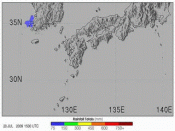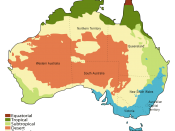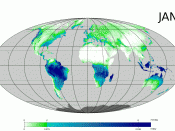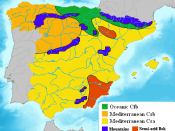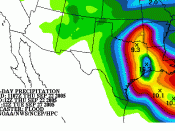The size and location of Australia ensures thatit has a wide range of climates. These can beseen on the map of climatic zones. Australia iswidely known as the `dry continent'. Around80 per cent of Australia has a rainfall of lessthan 600 mm per year and 50 per cent has lessthan 300 mm. Not only is the rainfall low but itis highly variable and droughts are a commonoccurrence.
Australian climatic zonesThe main reason Australia is so dry is that muchof the continent lies in an area dominated byhigh pressure for most of the year. High pressuresystems drift from west to east across the continentbringing dry, stable, sinking air. Thisresults in atmospheric conditions that are notfavourable for rainfall (see the weather map onthis page).
CLIMATE AND RAINFALLPRESSURE SYSTEMSOf all the inhabited continents, Australia has the lowestaverage yearly rainfall.
The movement of high pressure systems across the continentis the main reason why Australia is so dry.
As the rainfall maps opposite show, the wettestparts of Australia are the northern and easterncoastal areas and the west coast of Tasmania.
The northern part of Australia generally has asummer rainfall maximum. In summer, a troughof low pressure extends south from the Equatorand brings moist, unstable air in north-westerlywinds over the area (see the weather map).
Australia Eurasia NorthAmericaAfrica SouthAmerica1800150012009006003000it has a wide range of climates. These can beseen on the map of climatic zones. Australia iswidely known as the `dry continent'. Around80 per cent of Australia has a rainfall of lessthan 600 mm per year and 50 per cent has lessthan 300 mm. Not only is the rainfall low but itis highly variable and droughts are a commonoccurrence.
Australian climatic zonesThe main reason Australia is so dry is that muchof the continent lies in an area dominated byhigh pressure for most of the year. High pressuresystems drift from west to east across the continentbringing dry, stable, sinking air. Thisresults in atmospheric conditions that are notfavourable for rainfall (see the weather map onthis page).
This can lead to widespread rain, particularlynear the coast. This is often referred to as thenorth-west monsoon.
A summer low pressure trough brings rain to northernAustralia.
Also during the summer and autumn, tropicalcyclones can develop off the coast of northernAustralia and bring heavy rain, especially tocoastal areas. During winter much of the area isdominated by high pressure systems that havemoved further north. Dry and stable air from theinterior of Australia dominates the area andthere is little rainfall.
The southern part of Australia generally has awinter rainfall maximum. During winter, coldfronts in association with low pressure systemsmove further north over this area and bring coolmoist air and rain as the cold fronts passthrough. The heaviest rain falls on the coastalmargins, including the west coast of Tasmania.
The east coast receives rainfall throughout theyear. Much of this rain is brought by moist easterlywinds. The heavier falls of rain are generallyto the coast and highlands as thewestern side of the highlands lies in a rainshadowarea from the moist easterlies.
http://www.google.com.au/search?hl=en&q=pattern+climate+and+vegetation+in+Australia&meta=
